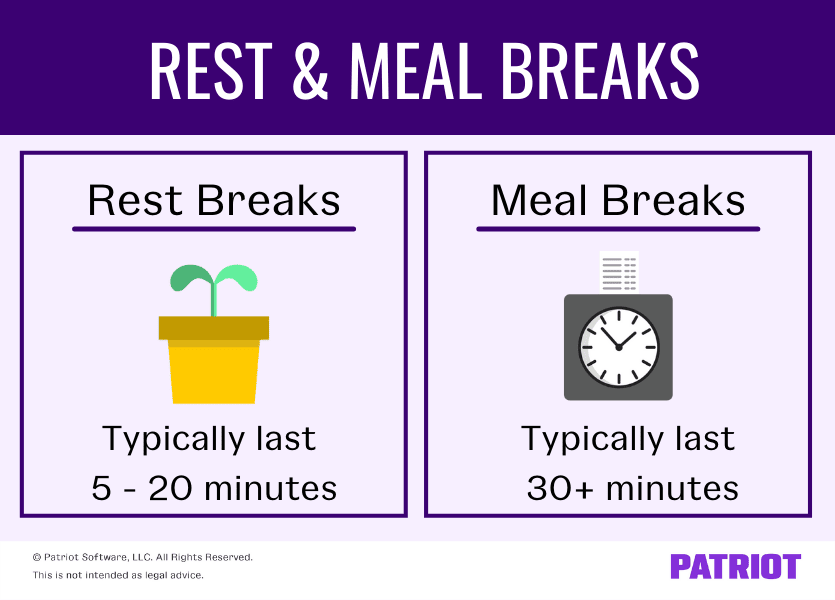We all need to rest and eat—including your employees. But, do you need to compensate employees for the time they spend resting and eating (aka are breaks required by law to be paid?). To answer this all-important question, you need to know employee break laws.
Read on to learn:
- Federal break laws for meal and rest periods
- State laws on meals and breaks
- Other types of breaks you may offer to employees
- How to create an employee break policy
Federal employee break laws on meal and rest periods
So, do you have to give employees meal and rest breaks under federal law? The Fair Labor Standards Act (FLSA) is a federal law that defines rest and meal breaks.
According to the Department of Labor (DOL), the FLSA does not require that employers provide snack or coffee breaks. But if you do offer short breaks (i.e., five to 20 minutes), you must include the time as compensable work hours—with some exceptions.
Take a closer look at FLSA breaks for rest and meal periods.
Rest breaks
Rest breaks usually last about five to 20 minutes. Again, include rest breaks in the total time an employee works if you offer them to employees.
Keep in mind that you may not need to count unauthorized extensions of authorized work breaks as hours worked.
Do not count work breaks as hours worked if you expressly and unambiguously communicated to the employee that:
- Authorized breaks may only last for a specific length of time,
- Any extension of the break is contrary to your rules, AND
- Any extension of the break will be punished.
Meal breaks
So, how long is a lunch break (or another type of meal break)? Meal breaks are typically 30 minutes or longer. You do not have to pay employees for meal breaks. You also do not have to include meal breaks in the total time employees work.
However, there is a catch when it comes to meal breaks. If an employee does any kind of work during the meal break, you must pay them for the break. The break also counts toward the total time the employee works.
So if an employee does something as simple as answering emails or phone calls, you must compensate them.

State work break laws
Although the FLSA does not require you to provide rest and meal breaks, your state might. Your state’s meal and/or rest break laws may depend on factors like hours worked and industry. Keep in mind that all states with paid rest period rules also have meal break rules.
Use the chart below to find the minimum requirements for meal and rest breaks by state. For more information on specific rules and exemptions, check out the DOL’s Paid Rest Period website and DOL’s Meal Period website.
| State | Rest Break Rule | Meal Break Rule |
|---|---|---|
| Alabama | N/A | N/A |
| Alaska | N/A | N/A |
| Arizona | N/A | N/A |
| Arkansas | N/A | N/A |
| California | Paid 10-minute rest period for each 4-hour work period (in the middle of work period, if possible). | 30 minutes if work shift is for more than 5 hours per day. |
| Colorado | Paid 10-minute rest period for each 4-hour work period (in the middle of work period, if possible). | 30 minutes if work shift is for more than 5 consecutive hours. |
| Connecticut | N/A | 30 minutes after first 2 hours and before last 2 hours for employees who work 7 ½ consecutive hours or more. |
| Delaware | N/A | 30 minutes after first 2 hours and before last 2 hours for employees who work 7 ½ consecutive hours or more. |
| D.C. | N/A | N/A |
| Florida | N/A | N/A |
| Georgia | N/A | N/A |
| Hawaii | N/A | N/A |
| Idaho | N/A | N/A |
| Illinois | 2 paid 15-minute rest periods each workday of at least 7 hours to all hotel room attendants. | At least 20 minutes, no later than 5 hours after the start of an employee’s 7 ½-hour or more workday. Employers must give a 30-minute meal period to hotel room attendants who work at least 7 hours. |
| Indiana | N/A | N/A |
| Iowa | N/A | N/A |
| Kansas | N/A | N/A |
| Kentucky | Paid 10-minute rest period for each 4-hour work period. | Reasonable off-duty period (typically 30 minutes) after 3 hours of work and before 5 hours of work. Meal break period does not count as time worked. Do not count coffee and snack breaks as meal periods. |
| Louisiana | N/A | N/A |
| Maine | N/A | 30-minute break after 6 consecutive hours. |
| Maryland | N/A | Employers must provide meal breaks based on the number of consecutive hours an employee works: 4-6 hours: 15-minute break More than 6 hours: 30-minute break 8 or more hours: 30-minute break + 15-minute breaks for every additional 4 consecutive hours worked |
| Massachusetts | N/A | 30-minute break for workdays more than 6 hours. |
| Michigan | N/A | N/A |
| Minnesota | Paid adequate rest period (less than 20 minutes) for each 4-hour work period for restroom breaks. | Sufficient unpaid time if employee works 8 consecutive hours or more. |
| Mississippi | N/A | N/A |
| Missouri | N/A | N/A |
| Montana | N/A | N/A |
| Nebraska | N/A | 30-minute lunch break (off-premises) per 8-hour shift. |
| Nevada | Paid 10-minute rest period for each 4-hour work period (in the middle of work period, if possible). | 30-minute break for employees who work 8 consecutive hours. |
| New Hampshire | N/A | 30-minute break after 5 consecutive work hours unless employee is able to eat while working. |
| New Jersey | N/A | N/A |
| New Mexico | N/A | N/A |
| New York | N/A | Employers must provide meal breaks as follows: 1 hour noonday period (factory workers) 30-minute noonday period for employees who work more than 6 hours over the noonday meal period (all other industries) Additional 20 minutes between 5 p.m. and 7 p.m. for employees who start a shift before 11 a.m. and work past 7 p.m. 45-minute break (1 hour in factories) midway in an employee’s shift for those working more than a 6-hour period that starts between 1 p.m. and 6 a.m. |
| North Carolina | N/A | N/A |
| North Dakota | N/A | 30-minute break (if desired) for employees who work more than 5 hours. |
| Ohio | N/A | N/A |
| Oklahoma | N/A | N/A |
| Oregon | Paid 10-minute rest period for each 4-hour work period (in the middle of work period, if possible). | 30-minute break for each work period of 6-8 hours; requirements on when to take break depend on work hours. |
| Pennsylvania | N/A | N/A |
| Rhode Island | N/A | 20-minute mealtime for 6-hour shifts and 30-minute mealtime for 8-hour shifts. |
| South Carolina | N/A | N/A |
| South Dakota | N/A | N/A |
| Tennessee | N/A | 30-minute break for employees scheduled to work 6 or more consecutive hours. |
| Texas | N/A | N/A |
| Utah | N/A | N/A |
| Vermont | Reasonable opportunities during work to eat and use toilet facilities. | Reasonable opportunities during work to eat and use toilet facilities. |
| Virginia | N/A | N/A |
| Washington | Paid 10-minute rest period for each 4-hour work period (in the middle of work period, if possible). Employers can’t require employees to work more than 3 hours without a rest period. | 30-minute break for employees who work more than 5 consecutive hours, given after the employee’s 2nd hour and before their 5th hour at work. The break counts as work time if the employee must remain on-duty and on-premises. Additional 30 minutes for employees working 3 or more hours beyond a regular workday. |
| West Virginia | N/A | 20-minute break for employees who work 6 or more hours. |
| Wisconsin | N/A | N/A |
| Wyoming | N/A | N/A |
Breaks for youth employees
Many states have laws about when you have to give breaks to employees who are under 18 years old.
Most times, the breaks you have to provide to minors are more frequent than the breaks you must give to adult employees. Requirements vary by state, so consult your state for more information.
Bathroom break
Unlike other kinds of breaks, you must provide employees with bathroom breaks under the Occupational Safety and Health Administration (OSHA).
OSHA requires that employees have access to toilet facilities. Also, you can’t force employees to follow a certain schedule for bathroom breaks.
Smoke break
Employees who smoke may want to take more frequent breaks. Under the FLSA, you are not required to give them breaks to smoke. But if you do let employees take breaks from five to 20 minutes long, you must count them as hours worked.
If employees take unauthorized breaks to smoke, you do not need to pay them or count the time toward their total time worked.
Health issue break
An employee might have a health issue that requires frequent breaks. If an employee has a health issue that falls under the Americans with Disabilities Act, you must provide the employee with “reasonable accommodation.” A reasonable accommodation is an adjustment that accommodates your employee’s needs.
For example, an employee who has diabetes may need to take additional breaks to eat and check their sugar and insulin levels. You should permit the employee to take additional breaks to tend to their health needs.
You do not have to make accommodations for an employee’s health needs if the accommodations would cause you “undue hardship” (e.g., difficulty or expense) to your business.
If an employee needs additional breaks to care for their health needs, make sure you have open communication with them. Find out exactly what the employee needs. You might also be able to work out a compromise with the employee.
Religious practice break
Employees might ask you for additional breaks to practice their religion. They might want to have extra time for prayers or religious readings.
You can provide the employee with reasonable accommodation as long as it doesn’t cause undue hardship for you.
Nursing mothers break
Under the FLSA, employers must provide nursing mothers with breaks so they can express breast milk for one year after the child’s birth. And, you must provide a private place that is not a bathroom for the employee to go.
You do not have to pay the employees for this time if it’s separate from compensated breaks, according to the FLSA. Keep in mind that your state laws may be different.
Creating your employee break policy
Want to avoid confusion and get employees on the same page? Create a meal and break periods policy to enforce your business’s rules.
Before creating your policy, you should:
- Review labor law breaks
- Consider your employees’ needs (i.e., reasonable accommodations)
- Pay attention to your business’s proximity to other businesses (e.g., restaurants)
After creating your policy, remember to:
- Communicate the rules to employees
- Add your policy to your business’s employee handbook
This article has been updated from its original publication date of March 16, 2016.
This is not intended as legal advice; for more information, please click here.



